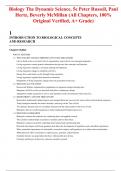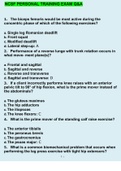© 2021 Cengage Learning. All Rights Reserved. May not be scanned, copied or duplicated, or posted to a publicly accessible website, in whole or in part. 1 INTRODUCTION TO BIOLOGICAL CONCEPTS AND RESEARCH Chapter Outline WHY IT MATTERS 1.1 WHAT IS LIFE? CHARACTERISTICS OF LIVING ORGANISMS Life on Earth exists at several levels of organization, each with its own emergent properties. Living organisms contain genetic information that govern s their structure and function . Living organisms reproduce , and many undergo development . Living organisms engage in metabolic activities . Energy flows and matter cycles through living organisms . Living organisms regulate their internal environment . Populations of living organisms change from one generation to the next . 1.2 BIOLOGICAL EVOLUTION Darwin and Wallace explained how populations of organisms change through time. Mutations in DNA are the raw materials that allow evolutionary change. Adaptations enable organisms to survive and reproduce in the environments where they live. 1.3 BIODIVERSITY AND THE TREE OF LIFE Researchers traditionally defined species and grouped them into successively more inclusive hierarchical categories. Today biologists identify the trunks, branches, and twigs on the Tree of Life. Two primary domains and one secondary domain form the major trunks on the Tree of Life. Biologists often use model organisms to study fundamental biological processes. 1.4 BIOLOGICAL RESEARCH Biologists confront the unknown by conducting basic and applied research. The scientific method helps researchers crystallize and test their ideas. Biologists conduct research by collecting observational and experimental data. Research often begins with basic questions that allow the development of hypotheses and controlled experiments . When controlled experiments are unfeasible, researchers employ null hypotheses to evaluate observational data. Molecular tools allow researchers to explore genes, genomes, and proteomes. Scientific theories are grand ideas that have withstood the test of time. Curiosity and the joy of discovery motivate scientific research. Biology The Dynamic Science, 5e Peter Russell, Paul Hertz, Beverly McMillan (All Chapters, 100% Original Verified, A+ Grade) © 2021 Cengage Learning. All Rights Reserved. May not be scanned, copied or duplicated, or posted to a publicly accessible website, in whole or in part. Learning Objectives 1. Describe seven characteristics of living systems that distinguish them from nonliving systems.
2. Identify the emergent properties at each level in the hierarchy of biological organization.
3. Explain how the structure of an organism's DNA governs its structure and function.
4. Diagram the movement of energy and nutrients through ecosystems and identify the roles that
plants, animals, fungi, and microorganisms play in these processes.
5. Explain how natural selection can change the characteristics of a population from one
generation to the next.
6. Compare the information content of a hierarchical classification to that of a phylogenetic tree.
7. Distinguish between the primary and secondary domains of living systems and identify the
distinguishing characteristics of the major groups of eukaryotes.
8. Explain how scientists explore new ideas and observations in a formalized method of inquiry.
9. Formulate scientific hypotheses and define how experimental or observational data can test
the predictions of those hypotheses.
Key Terms cell emergent properties unicellular organisms multicellular organisms population community ecosystem biosphere deoxyribonucleic acid (DNA) nucleotides genome genes ribonucleic acid (RNA) proteins gene expression messenger RNA (mRNA) transcription translation ribosomes metabolism photosynthesis cellular respiration primary producers consumers decomposers homeostasis reproduction inheritance development life cycle biological evolution artificial selection natural selection mutations adaptations species genus scientific name family order class phylum kingdom domain phylogenetic trees prokaryotes eukaryotes organelles model organisms biological research basic research applied research scientific method observational data experimental data hypothesis null hypothesis variables predictions alternative hypotheses control experimental variable replicates genomics proteomics proteome bioinformatics systems biology scientific theory © 2021 Cengage Learning. All Rights Reserved. May not be scanned, copied or duplicated, or posted to a publicly accessible website, in whole or in part. Lecture Outline Why It Matters A. Countless organisms exist all over the world. 1. Animals, plants, and even bacteria interact and rely on one another to exist. 2. Organisms live, interact, and die every second of every day. B. Biology is the science of life. 1. Biology answers questions regarding the beginnings of life, how life persists, and how life is changing. 2. Biologists conduct research to better understand living systems. 1.1 What Is Life? Characteristics of Living Organisms A. Living organisms and inanimate objects have fundamental differences (Figure 1.1). 1. Living organisms have particular atoms and molecules that are organized and interact in specific ways. 2. Living organisms gather energy and materials from their surroundings to build new biological molecules. 3. Living organisms grow, maintain their structure, respond to environmental changes, produce new offspring, and change through generations. B. Life on Earth exists at several levels of organization, each with its own emergent properties (Figure 1.2). 1. Cells are the smallest units of life that can survive and reproduce. a. Unicellular organisms, such as bacteria, are those made of one cell. b. Multicellular organisms, such as plants and animals, are made of many cells interacting together. 2. Populations are groups of similar organisms that live together in the same place. 3. Communities are made of the many populations of organisms that live in a certain place together. 4. Ecosystems include communities and the nonliving environmental factors in which they interact. 5. At the highest level, the biosphere includes all ecosystems existing in the world. C. Living organisms contain genetic information that governs their structure and function. 1. DNA (deoxyribonucleic acid) is the fundamental molecule that distinguishes living from nonliving matter (Figure 1.3). a. DNA is used as a blueprint to make RNA (ribonucleic acid) (Figure 1.4). b. Information in RNA is used to make protein (Figure 1.4). c. Proteins carry out most activities of life, including the synthesis of all other biological molecules (Figure 1.4). D. Living organisms reproduce, and many undergo development. 1. Reproduction is the process in which parent organisms produce offspring. 2. Parent organisms pass on copies of their DNA to offspring, resulting in offspring that resembles them. a. The transmission of DNA from one generation to the next is called inheritance. 3. Multicellular organisms undergo development, a series of programmed changes that transform them from egg to adult organism. a. Moths begin as eggs, hatch into caterpillar larval stages, and then spin a cocoon where they eventually develop into an adult moth (Figure 1. 5). b. The sequential stages through which an organism develops, grows, maintains itself, and reproduces is referred to as the life cycle of that organism. E. Living organisms engage in metabolic activities. 1. Metabolism describes the activities a cell undergoes to obtain energy and use that energy to maintain itself, grow, and reproduce. 2. Metabolism includes chemical reactions to assemble, alter, and disassemble molecules as needed. a. Photosynthesis is the process in which plants capture energy from the sun and store energy as sugar (Figure 1. 6). b. Cellular respiration is the process in which most organisms break down molecules to release energy for their use. F. Energy flows and matter cycles through living organisms. 1. Light from the sun supports most life on Earth. a. Primary producers use sunlight to produce energy used by all other living organisms. b. Consumers feed on the complex molecules manufactured by producers (Figure 1. 7). c. Decomposers, such as some bacteria and fungi, feed on the dead remains of organisms. 2. Energy flows from the sun to the many organisms existing on Earth. a. Transfer of energy from one organism to another is not 100% efficient. © 2021 Cengage Learning. All Rights Reserved. May not be scanned, copied or duplicated, or posted to a publicly accessible website, in whole or in part. b. Some energy is lost as heat during the flow from one organism to another. G. Living organisms regulate their internal environment. 1. Living organisms have receptors on their cells or body that detect either internal or external conditions. a. Skin receptors detect changes in temperature and send signals to your brain. b. Signals make you shiver when you are cold and sweat when you are hot. 2. Most organisms have mechanisms to maintain homeostasis, a steady internal condition maintained by responses that compensate for changes in the external environment. H. Populations of living organisms change from one generation to the next. 1. Although most organisms resemble their parents, sometimes novel characteristics are seen in offspring. 2. Populations change from one generation to the next due to changes in DNA. 1.2 Biological Evolution A. Darwin and Wallace explained how populations of organisms change through time (evolve). 1. Fossil evidence demonstrates that extinct forms of organisms resemble living forms. 2. Fossil evidence also demonstrates that extinct forms of organisms were different than living forms. 3. Darwin studied domesticated animals to demonstrate that organisms can change through time. a. Domesticated pigeons vary from the ancestral forms through the process of artificial selection of traits (Figure 1.8). b. Natural selection is the process of change in organisms associated with differential success in survival and breeding. B. Mutations in DNA are the raw materials that allow evolutionary change. 1. Functional units in DNA that code for protein are called genes. 2. Random changes in DNA (mutations) may change the development of an organism. 3. Beneficial mutations may give an organism an advantage (e.g., survival, reproductive ability) and may be passed on to future generations. C. Adaptations enable organisms to survive and reproduce in the environments where they live. 1. Characteristics that allow organisms to survive longer or reproduce more are called adaptations. 2. Michael Nachman and his colleagues studied coloration in pocket mice and could associate cryptic coloration with survival and reproduction (Figure 1.9). 3. Nachman also determined that differences in DNA are attributed to difference in coloration. 1.3 Biodiversity and the Tree of Life A. Researchers traditionally defined species and grouped them into successively more inclusive hierarchical categories. 1. Species are groups of organisms with similar structure, biochemistry, and behavior such that they can successfully interbreed. 2. A genus is a group of organisms that share common recent ancestry. 3. Each species is assigned a two -part scientific name that identifies its genus and species. a. Scientific names are always written in italics or else underlined. b. The genus name is always capitalized, followed by the species name written in lowercase letters. 4. Other levels by which organisms are grouped based on similarity include family, order, class, phylum, kingdom, and domain (Figure 1.10). B. Today biologists identify the trunks, branches, and twigs on the Tree of Life. 1. Biologists now use DNA sequence and other biological molecules to trace evolutionary pathways called the phylogenetic tree. 2. Phylogenetic trees show how an ancestor gave rise to its descendants, producing the great diversity of life. 3. A phylogenetic tree often parallels the traditional hierarchical classification. 4. The Tree of Life is now reconstructed from data on the genetics, structure, metabolic processes, and behavior of living things, as well as from fossil data. C. Two primary domains and one secondary domain form the major trunks and branches on the Tree of Life. 1. The two primary domains of all organisms are the Bacteria, Archaea, and the one secondary domain is the Eukarya (Figure 1. 13). a. Bacteria and Archaea are described as prokaryotes based on their cellular structure (Figure 1.12a). b. Eukarya are described as Eukaryotes based on their cellular structure (Figure 1.12b). 2. Bacteria are unicellular organisms that are microscopic in size (Figure 1.13a). a. Bacteria are producers , consumers, or decomposers.








